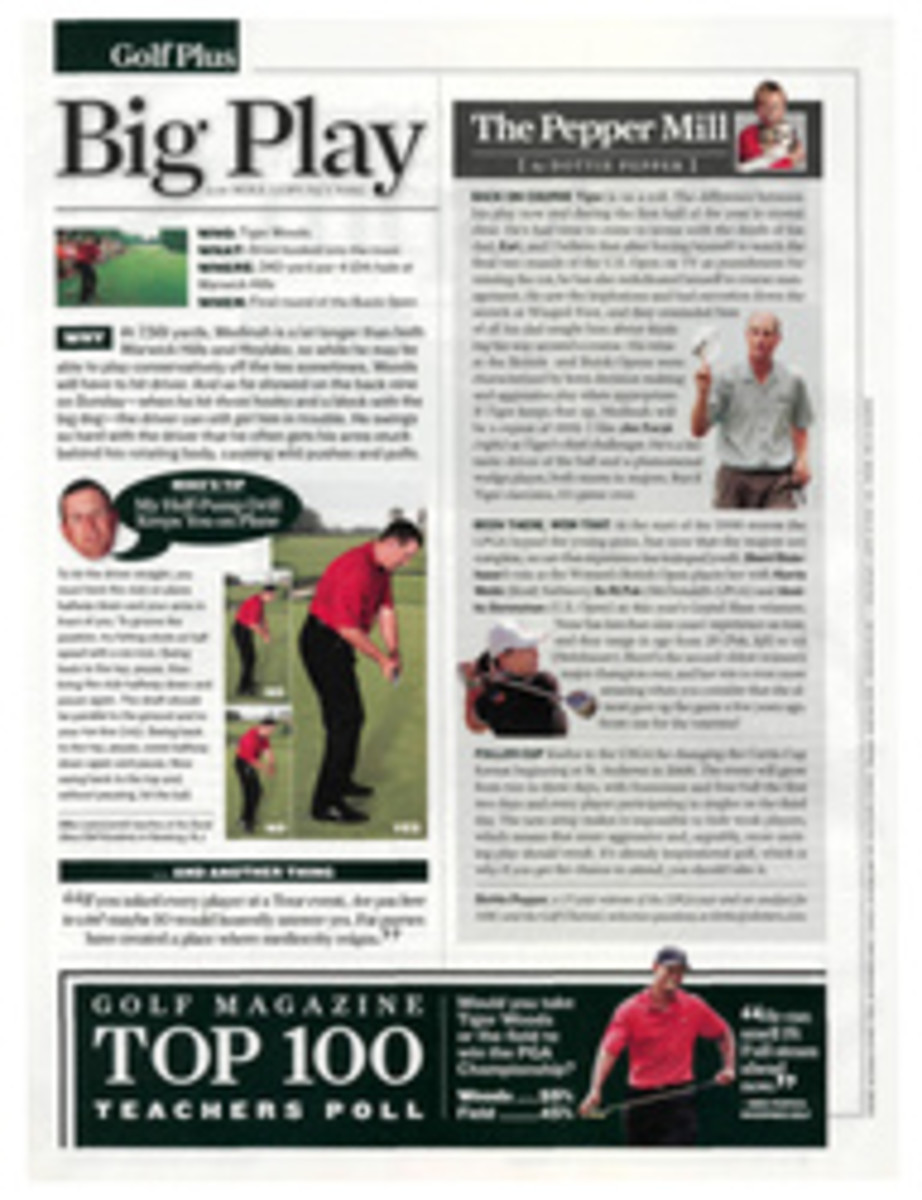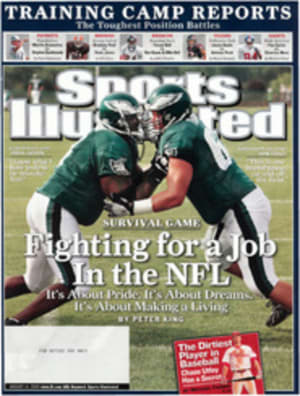
Chicagoland Dream 18
The New York Cityenvirons have a passel of swell clubs, and Philadelphia is home to old-linegolfing tradition, but only Chicago can call itself Golftown U.S.A. ¶ The 366member clubs in the Chicago District Golf Association are a mix made to matchthe sensibilities of the heartland golfer. There are the private jewels likeMedinah, Chicago Golf Club and Butler National but also an unmatched collectionof classic public courses--Cog Hill, Cantigny and Harborside, to name only afew. ¶ H.S. Colt, C.B. Macdonald, Seth Raynor, Donald Ross, A.W.Tillinghast--all the greats worked Chicagoland's rich soil, making theselection of a Dream 18 encompassing the area's most fascinating holes adifficult task. (Our handpicked panel agreed that a second Dream 18 would yielda course as design-rich as the first.) ¶ Throw in the Western GolfAssociation's 76-year-old Evans Scholarship program for caddies and you have itall in Golftown U.S.A.
1. Chicago Number2
One of many St.Andrews Road Hole adaptations, this is an original Chicago Golf Club holedesigned by C.B. Macdonald and renovated by his sidekick, Seth Raynor.
Keiser:"Macdonald's best 'manufactured' par-4s are known for their ingenioussculptures--such as the gorgeous and challenging green on this hole."
2. Beverly Number11
Richards:"Originally dubbed Old Profanity, the hole demands a tee shot to the rightof the bunker on the left, bringing out-of-bounds along the railroad tracksinto play. The second shot must avoid a large fairway bunker about 220 yardsfrom the green as well as the traps to the right at about 120 to 160 yards. Twobunkers right and another one left guard a large green with a dead elephant inthe center. Chick Evans called this 'one of the great holes of golf.'"
3. Cog Hill No. 4Number 16
The most recenthome of the Western Open will soon undergo a redesign by Rees Jones in hopes ofluring a U.S. Open to Dubsdread. But significant changes to this hole areunlikely.
Sherman: "Thispar-4 is my favorite, with the creek running along the dogleg on the left.Number 16 is the most picturesque hole on the course."
4. Glen Oak Number8
Shean:"Designed by Tom Bendelow and modified by A.W. Tillinghast, among others,the course's classic short par-4 is only 292 yards long with an elevated greenfronted by bunkers and surrounded by oak trees. While it is tempting to whaleaway with a driver, the penalty for missing this severely back-to-front slopinggreen makes a five-iron and a wedge a better choice."
5. George W. DunneNational
Number 7
Jemsek: "TheDick Nugent--designed green is surrounded by bunkers at one, four, seven and 11o'clock, but a fifth bunker directly in front splits the green into east andwest sections. A large bump in the green allows players to putt around thebunker."
6. HarborsideInternational Port Number 16
Jemsek: "Fromthe tee one has a long view of Lake Calumet about 60 feet below. The drivebetween bunkers to the right and the lake on the left plays downhill to apeninsula green that hangs out into the lake."
7. Glen ClubNumber 17
Keiser: "Withthe green and the area surrounding it shaved to USGA championship standards,this is one of Tom Fazio's best holes."
8. Olympia FieldsNorth Number 14
Shean: "Partof Willie Park Jr.'s original design, the fairway is in a valley protected onthe right side by a creek that then cuts back across the fairway about 100yards from the elevated green."
Keiser: "[Thisis] like the 11th at Shoreacres, another wonderfully natural par-4 playingaround a beautifully sculpted ravine."
9. ShoreacresNumber 15
Seth Raynor's epic1916 design sits on Lake Michigan, but the lake never comes into play.
Shean: "Areachable par-5 that doglegs slightly left in the landing area, with a ravineleft. A tee shot to the deep right-center of the fairway opens up the bestapproach angle to a slightly sloping green. Hazards split the lay-up landingarea, creating an alternate fairway."
10. Pine MeadowNumber 14
Many think thatthis Joe Lee--Rocky Roquemore design is the best public course, overall, in thearea.
Jemsek:"Called T-Bone, the hole demands a 200-yard carry over a water hazard thatturns and follows the fairway on the right side all the way to the green. Abunker on the left pinches the landing area. The green has four subtletiers."
11. Beverly Number8
Jemsek: "It'shard to select a par-4 on a course that has three great par-5s, but the65-yard-deep green named Punchbowl is that different and interesting."
Richards:"When the Western Golf Association visited here in preparation for the 1963Western, officials felt that the hole wasn't long enough. Since there were onlywoods and open space behind Donald Ross's Punchbowl, they told the club tobuild a new green 'back there' [to] lengthen the hole. After the new green wasbuilt, club officials had a change of heart and decided they didn't want tolose the original, so they simply connected the old with the new."
12. CantignyWoodside Number 2
This RogerPackard-- designed layout was built to honor the will of former Chicago Tribunepublisher Robert McCormick; the course sits on his estate.
Sherman: "Agood risk-reward scenario for the better player. The green is surrounded by acreek in front and a pond in back."
13. ShoreacresNumber 11
Shean: "Thefairway is protected by woods on the left and an 80-foot-deep ravine that runsdown the right side of the fairway and then sweeps in front of thegreen."
O'Donnell:"If, like me, you grew up in Chicago but played elsewhere, you realize howflat most of the area courses are, making this hole dramatic andspecial."
14. Medinah No. 3Number 12
The only hole nottouched by designer Rees Jones in advance of next week's PGA Championship.
Shean: "Thedrive is to a tight fairway that slopes dramatically left to right withbeautiful rolls that leave few flat lies. The approach is to a large, elevatedgreen that falls sharply to the right toward an all-too-visible pond."
15. Skokie Number12
A Donald Rosscourse, Skokie hosted the 1922 U.S. Open won by Gene Sarazen but was laterredesigned by cult favorites Langford and Moreau. It was recently restored byRon Prichard.
Richards: "Thesetting is serene--square tee boxes, water between tee and green, forestpreserve to the left and behind the green. The tee shot is intimidating. Can Icarry the water? If I do, will my shot hit the severe face that lies below thegreen? If it carries, will it hold? The green is larger than it appears fromthe tee and has multiple ridges and contours, so simply reaching the green isonly half the battle."
16. SydneyMarovitz Number 5
Sherman:"Running along Lake Michigan and part of a public, 3,240-yard nine-holeroff Lake Shore Drive, the hole offers a terrific view of the lake and theskyline. There's not another like it in Chicago."
17. Chicago Number7
Shean: "One ofthe great Redan holes in the U.S. There are a whopping 20 yards between thefalse front and the ridge at the apex of the 50-yard-long green. From the ridgethe green slopes down severely to the left, and the rear corners are squaredoff."
18. ButlerNational Number 18
Always one of thePGA Tour's toughest holes when this George and Tom Fazio design hosted theWestern from 1977 to '90.
Sherman: "Onelast punch to the jaw on the way in."
For the Dream 18panel's Best of Chicagoland, go to SI.com/golf.
PGA Blog
Read John Garrity's PGA Championship blog beginning onAug. 16 at SI.com/golf.
PHOTO
FRED VUICH/GOLF MAGAZINE
SELECT COMPANY Medinah's par-4 12th was the only hole from next week's PGA venue to make the Dream 18.
MAP
Routing and course map by Gil Hanse

